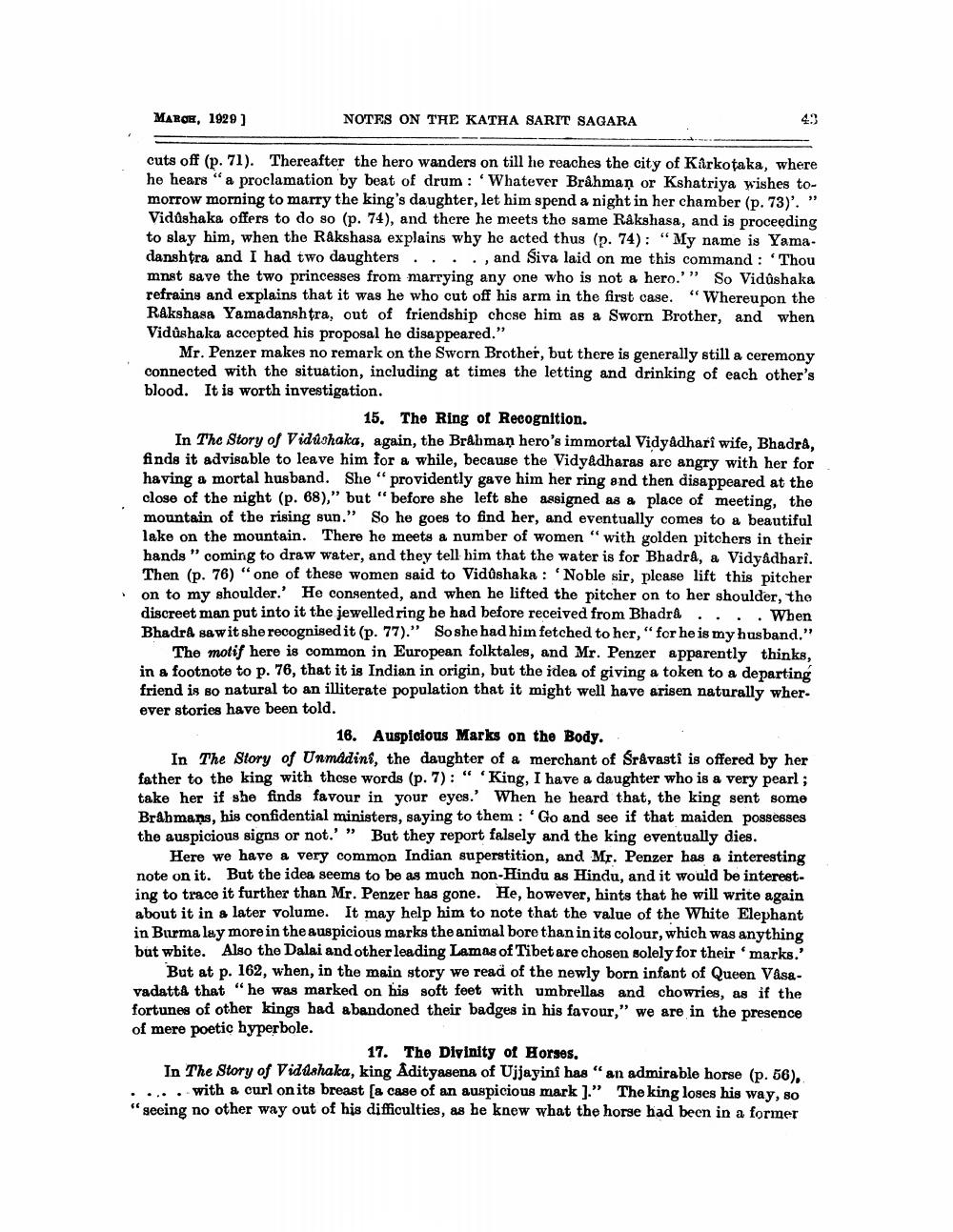________________
MAROE, 1929 ]
NOTES ON THE KATHA SARIT SAGARA
cuts off (p. 71). Thereafter the hero wanders on till he reaches the city of Karkotaka, where he hears "a proclamation by beat of drum: Whatever Brahman or Kshatriya wishes tomorrow morning to marry the king's daughter, let him spend a night in her chamber (p. 73)'. "
Vidőshaka offers to do so (p. 74), and there he meets the same Rakshasa, and is proceeding to slay him, when the Rakshasa explains why he acted thus (p. 74): "My name is Yamadanshtra and I had two daughters...., and Siva laid on me this command : Thou mnst save the two princesses from marrying any one who is not a hero.'” So Vidushaka refrains and explains that it was he who cut off his arm in the first case. "Whereupon the Rakshasa Yamadanshtra, out of friendship chose him as a Sworn Brother, and when Vidůshaka accepted his proposal he disappeared."
Mr. Penzer makes no remark on the Sworn Brother, but there is generally still a ceremony connected with the situation, including at times the letting and drinking of each other's blood. It is worth investigation.
15. The Ring of Recognition. In The Story of Vidushaka, again, the Brahman hero's immortal Vidyadhari wife, Bhadra, finds it advisable to leave him for a while, because the Vidyadharas are angry with her for having a mortal husband. She "providently gave him her ring and then disappeared at the close of the night (p. 68),” but “before she left she assigned as a place of meeting, the mountain of the rising sun." So he goes to find her, and eventually comes to a beautiful lake on the mountain. There he meets a number of women with golden pitchers in their hands" coming to draw water, and they tell him that the water is for Bhadra, a Vidyadhari. Then (p. 76) "one of these women said to Vidushaka : 'Noble sir, please lift this pitcher on to my shoulder. He consented, and when he lifted the pitcher on to her shoulder, the discreet man put into it the jewelled ring he had before received from Bhadra.... When Bhadra sawit she recognised it (p. 77)." So she had him fetched to her, "for he is my husband."
The motif here is common in European folktales, and Mr. Penzer apparently thinks, in a footnote to p. 76, that it is Indian in origin, but the idea of giving a token to a departing friend is so natural to an illiterate population that it might well have arisen naturally wher. ever stories have been told.
16. Auspicious Marks on the Body. In The Story of Unmadini, the daughter of a merchant of Sråvastî is offered by her father to the king with these words (p. 7): “ 'King, I have a daughter who is a very pearl ; take her if she finds favour in your eyes.' When he heard that, the king sent some Brahmans, his confidential ministers, saying to them : 'Go and see if that maiden possesses the auspicious signs or not.' ” But they report falsely and the king eventually dies.
Here we have a very common Indian superstition, and Mr. Penzer has a interesting note on it. But the idea seems to be as much non-Hindu as Hindu, and it would be interest. ing to trace it further than Mr. Penzer has gone. He, however, hints that he will write again about it in a later volume. It may help him to note that the value of the White Elephant in Burma lay more in the auspicious marks the animal bore than in its colour, which was anything but wbite. Also the Dalai and other leading Lamas of Tibet are chosen solely for their marks.'
But at p. 162, when, in the main story we read of the newly born infant of Queen Vasavadatta that "he was marked on his soft feet with umbrellas and chowries, as if the fortunes of other kings had abandoned their badges in his favour," we are in the presence of mere poetic hyperbole.
17. The Divinity of Horses. In The Story of Vid dshaka, king Adityasena of Ujjayini has "an admirable horse (p. 56), .....with a curl on its breast (8 case of an auspicious mark ].” The king loses his way, so “geeing no other way out of his difficulties, as he knew what the horse had been in a former




